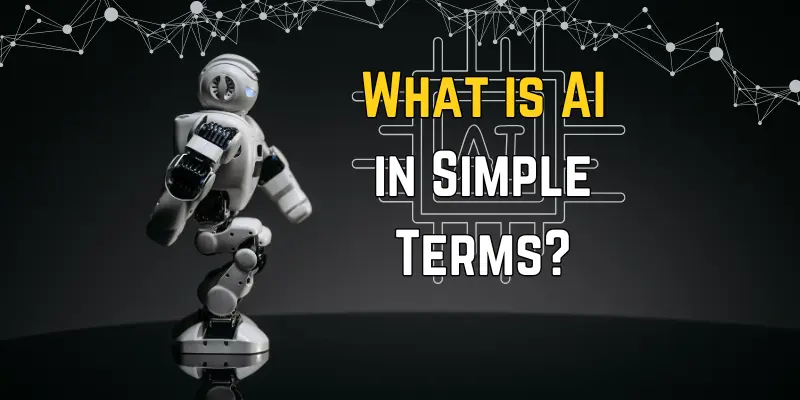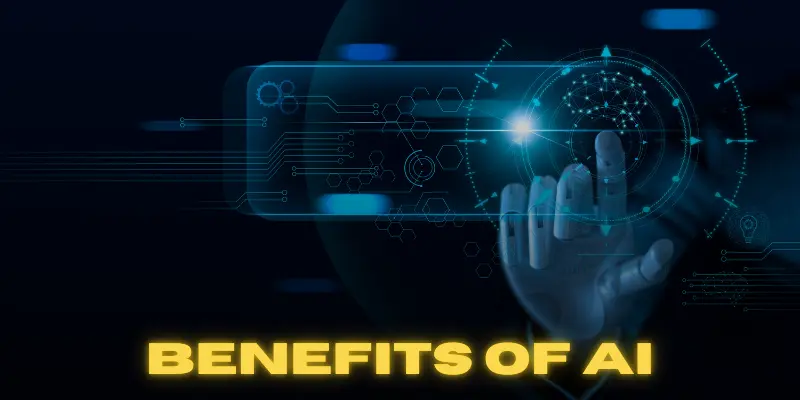What is AI? Discover How It Works & Its Benefits
Published: 31 Jan 2025
Imagine a world where your car drives itself, your music playlists seem to know your mood, and your doctor’s advice is powered by an intelligent system. This is all possible today, thanks to Artificial Intelligence (AI). It’s no longer a distant dream but an everyday reality. Let’s dive into What is AI and how it’s transforming our world.
What is AI in Simple Terms?

Artificial Intelligence (AI) is a type of technology that allows machines to think, learn, and make decisions, almost like a human. In simple terms, AI means programming computers to do tasks that usually require human intelligence—like understanding speech, recognizing pictures, or even making recommendations.
So why does AI matter today? Well, it’s everywhere! From the moment you wake up and ask your voice assistant, like Siri or Alexa, about the weather, to when you’re browsing online shopping sites that suggest products based on your past purchases—AI is working behind the scenes, making things faster and more convenient. In fact, AI is becoming a part of nearly every aspect of our lives, helping us solve problems, save time, and even improve our everyday experiences.
- Artificial Intelligence (AI) refers to machines or software that are designed to mimic human thinking and actions.
- AI can learn from data, recognize patterns, make decisions, and even solve problems—much like a human brain.
- It is used in many areas, from recognizing images to speaking with chatbots and playing complex games.
Simple Definition of AI
- AI is technology that makes machines smart.
It enables machines or programs to think, learn, and act in ways that are similar to humans. - AI can perform tasks that usually need human intelligence.
For example, understanding spoken language or recognizing images. - AI can make decisions based on information it receives.
It processes data, draws conclusions, and takes actions based on those conclusions.
Example:
- AI can recognize pictures, like identifying a cat in a photo.
- AI can understand speech, like when you ask your phone for the weather.
- AI can even play games, like chess or video games, where it learns and improves as it plays.
Types of AI
Narrow AI (Weak AI)
- Narrow AI is AI that is designed to perform specific tasks or solve one problem at a time.
- It is called “weak” because it only works well in the area it’s programmed for—nothing else.
Example:
- A self-driving car uses narrow AI to follow traffic rules, stop at traffic lights, and avoid obstacles.
- But, it can’t do anything outside of driving, like helping you cook or playing music.
Common Uses of Narrow AI:
- Chatbots like those on websites that answer simple questions.
- Voice Assistants like Siri, Alexa, or Google Assistant that help with tasks like setting reminders or playing music.
General AI (Strong AI)
- General AI is the type of AI that can perform any intellectual task that a human can do.
- It’s still not fully achieved. Researchers are still working on making AI as versatile as a human brain.
Example:
- General AI would be like a robot that can not only drive a car but also understand complex problems, learn new tasks on its own, and think critically across different subjects.
What’s the Challenge?
- Unlike narrow AI, General AI can’t be trained for just one task. It must learn and adapt to many different kinds of activities, just like humans.
- Currently, we only have narrow AI. General AI is still a concept being explored by researchers and scientists.
How Does AI Work?
AI works by learning from data, recognizing patterns, and making decisions based on the information it receives. Just like humans learn from experience, AI learns from the data it’s given and improves over time.
Machine Learning
- Machine learning is the core of how AI learns.
It’s a method where AI gets smarter by analyzing lots of data and finding patterns or trends. - AI doesn’t need to be told what to do.
Instead of programming AI for every action, it learns how to do tasks by itself through examples. - Machine learning is like practice for AI.
The more data AI is given, the better it gets at completing tasks. It’s just like how you get better at something the more you practice.
Example:
- Just like how you learn from practice, AI learns by studying lots of examples. For instance, an AI might look at thousands of pictures of dogs and cats, so it learns how to tell the difference between them.
Neural Networks
- Neural networks are inspired by the human brain.
These are special algorithms designed to process information in a way that mimics how our brain works. - AI breaks problems into smaller pieces.
Just like our brain uses neurons to process information, neural networks break down a problem into smaller parts, each piece helping to make a decision. - Neural networks help AI recognize patterns and images.
When AI looks at data, it uses a neural network to understand and recognize what’s in front of it.
Example:
- A neural network helps AI recognize a dog in a photo, similar to how our brain processes images. For example, when you see a picture of a dog, your brain identifies it by matching patterns from past experiences. AI does the same with a neural network: it processes pixels in a photo, compares them to thousands of similar images, and then decides whether it’s a dog or not.
Everyday Examples of AI
AI is everywhere in our daily lives, even if we don’t always notice it. From helping us with tasks on our smartphones to recommending our next favorite movie or song, AI is making things easier and more personalized.
Smartphones
- AI powers voice assistants like Siri, Google Assistant, and Alexa.
These assistants use AI to understand what you say and provide helpful answers or complete tasks. - AI helps in everyday tasks such as setting alarms, sending texts, or getting directions.
It listens, processes, and responds to your commands—just like a personal assistant.
Example:
- When you ask your phone a question, such as “What’s the weather today?” it uses AI to understand your words, search for the information, and respond with an answer. This is the magic of AI working in the background!
Streaming Services
- AI recommends content on platforms like Netflix, YouTube, or Spotify based on your preferences and viewing habits.
It learns what you like and suggests movies, videos, or music you might enjoy. - AI personalizes your experience by analyzing what you watch or listen to, and predicting what you’d like next.
Example:
- Ever wonder how Netflix knows what you might like to watch? AI looks at what you’ve watched before, finds similar content, and suggests shows or movies you might enjoy based on that. It helps you discover new content without searching for hours!
E-commerce
- AI is used in online shopping to recommend products you might want to buy.
Sites like Amazon use AI to analyze your past purchases, browsing history, and other users’ actions to suggest items. - AI improves the shopping experience by making it faster and more personalized, helping you find what you’re looking for with ease.
Example:
- You know how Amazon suggests things you might buy? That’s AI at work! It looks at what you’ve bought before, what you’ve browsed, and even what other shoppers have bought, to recommend products you’ll likely be interested in.
Benefits of AI
AI is not just a cool technology; it brings real-world benefits that can improve the way we live and work. From saving time to making better decisions, AI has the potential to make everything more efficient.

Improves Efficiency
- AI helps save time by completing tasks much faster than humans.
It can handle large amounts of data or complex tasks quickly and without breaks, allowing us to focus on other important work. - AI can do repetitive tasks without getting tired or making mistakes.
Whether it’s sorting data, answering simple questions, or processing information, AI can get the job done faster than a human.
Example:
- AI can quickly check thousands of emails to find important ones. Instead of manually sorting through your inbox, AI can automatically flag important messages and help you prioritize them, saving you lots of time.
Helps in Decision-Making
- AI uses data to make smarter decisions.
AI can analyze huge amounts of data, identify patterns, and recommend the best course of action based on that information. This helps businesses and individuals make better choices. - AI doesn’t just guess—it makes informed decisions.
AI is trained to use historical data, so it can make decisions based on facts and past trends, leading to better outcomes.
Example:
- AI helps doctors choose the best treatment for patients by looking at medical records. By analyzing a patient’s history, AI can recommend treatment options that are more likely to be effective, helping doctors make more informed and timely decisions.
Common Myths About AI
Despite the growing presence of AI in our daily lives, there are a lot of myths and misunderstandings about what AI can and cannot do. Let’s clear up some of these common myths.
AI is Like a Human Brain
- Myth: Many people believe that AI is just like the human brain, capable of thinking, feeling, and making complex decisions.
- Reality: AI is not like a human brain. While it can perform tasks that mimic human intelligence (like recognizing images or understanding speech), it doesn’t think, feel, or have emotions like a human does. AI is really good at specific tasks, but it lacks the general understanding and creativity that humans have.
Example:
- AI can help doctors with diagnosis, but it doesn’t have empathy. It might analyze medical data to identify patterns, but it cannot understand the emotions or personal context of a patient like a human doctor can.
AI Will Take Over All Jobs
- Myth: Some people fear that AI will take over all jobs, leaving people without work.
- Reality: While AI can automate certain tasks, it does not replace all jobs. Instead, it helps humans by taking care of repetitive, time-consuming tasks. Many jobs still need human creativity, problem-solving, and emotional intelligence—skills that AI lacks.
Example:
- AI can help doctors by analyzing medical images, but we still need human doctors for patient care, providing advice, and understanding the emotional needs of patients.
The Future of AI
AI is not standing still. It’s growing rapidly and evolving into even more powerful tools that could change many industries, from healthcare to education. The future of AI holds exciting possibilities that could make our lives easier, healthier, and more efficient.
How AI Will Evolve
- AI will continue to get smarter and more capable. As technology advances, AI systems will improve in their ability to understand complex problems, make decisions, and interact with humans in more natural ways.
- AI will be integrated into more industries to solve real-world problems. It’s already making waves in areas like healthcare, education, and transportation, and it’s likely to play a bigger role in the future.
- AI will become more personalized. In the future, AI will be able to tailor solutions to individual needs, whether it’s in learning, healthcare, or shopping.
Example:
- In the future, AI might help teachers create personalized lessons for every student. AI could analyze each student’s progress, strengths, and weaknesses, and create lessons that fit their individual learning pace. This could make education more accessible and effective for everyone, regardless of their starting point.
Potential Future Applications of AI:
- Healthcare: AI could help doctors diagnose diseases more accurately by analyzing medical records and lab results faster than a human can. It might also assist in developing personalized treatment plans based on genetic information.
- Transportation: Self-driving cars and AI-powered traffic management systems could reduce accidents and make travel more efficient.
- Entertainment and Media: AI might help create custom content, from movies to video games, based on your personal tastes, making your experience more immersive and enjoyable.
- Customer Service: Chatbots and AI assistants will get even better at understanding your needs and solving problems in real time, with even more human-like interactions.
Conclusion
So guys, in this article, we’ve covered What is AI in detail. As you can see, AI is not just a futuristic idea—it’s already a big part of our lives and continues to shape the world in new ways.
My personal recommendation is to stay curious about AI and start exploring its applications in your own daily life, whether through voice assistants or personalized recommendations.
It’s an exciting field that will only grow. So, why not dive deeper and see how AI can make your life easier? Keep learning, and feel free to check out more articles to stay updated on all things AI!
FAQs about AI
AI, or Artificial Intelligence, refers to machines or software that can perform tasks that typically require human intelligence. These tasks include recognizing speech, making decisions, and understanding images. AI works by learning from data, just like how humans learn from experience.
AI learns through a process called machine learning, where it analyzes large amounts of data to find patterns. The more data it gets, the better it becomes at making decisions or predictions. It’s similar to how you learn from practice or repetition.
No, AI cannot think or feel like humans. While it can process information and solve specific problems, it lacks human emotions and consciousness. AI can only do tasks it’s been trained to perform, and it doesn’t have creativity or complex reasoning like humans do.
AI is unlikely to take over all jobs, but it will automate certain tasks, especially repetitive ones. Instead of replacing humans, AI is more likely to help workers by doing tasks like data processing or customer service. Many jobs still require human creativity, judgment, and emotional intelligence.
AI is everywhere in your daily life—from voice assistants like Siri or Alexa to recommendations on Netflix or YouTube. It’s also used in online shopping to suggest products based on what you’ve browsed or purchased. Even self-driving cars use AI to make decisions on the road.
Narrow AI is designed for specific tasks, like voice assistants or recommendation systems. General AI, which is still in development, would be capable of performing any intellectual task a human can do. Most AI today is narrow AI, focused on one area.
Yes, AI can make decisions, but those decisions are based on data and algorithms. It doesn’t “think” like a human but analyzes data to choose the best option based on patterns. For example, AI can recommend the best treatment for a patient by looking at medical records.
AI helps in healthcare by analyzing medical data, detecting patterns, and assisting doctors with diagnoses. It can even predict potential health issues before they occur, based on a patient’s records. While AI can’t replace doctors, it can support them in providing better, more personalized care.

- Be Respectful
- Stay Relevant
- Stay Positive
- True Feedback
- Encourage Discussion
- Avoid Spamming
- No Fake News
- Don't Copy-Paste
- No Personal Attacks

- Be Respectful
- Stay Relevant
- Stay Positive
- True Feedback
- Encourage Discussion
- Avoid Spamming
- No Fake News
- Don't Copy-Paste
- No Personal Attacks



